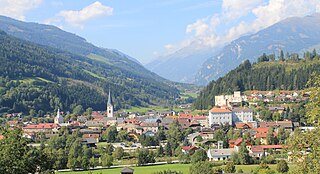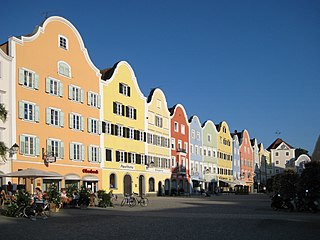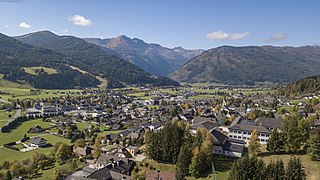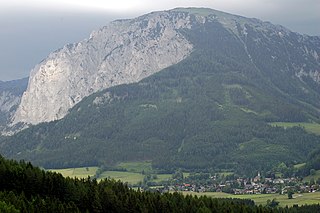
Petting is a municipality in the district Traunstein, Bavaria, Germany. It is located on the shore of the Waginger See, a diluvial lake.

Hallein is a historic town in the Austrian state of Salzburg. It is the capital of Hallein district.

Mittersill is a city in the federal state of Salzburg, Austria, in the Pinzgau region of the Alps. It is located on the Salzach River. It has a population of 5,408 as of 2011.

Krimml is a municipality in Zell am See District, in the federal state of Salzburg, Austria, in the Pinzgau region.

Gmünd in Kärnten is a municipality and historic town in the district of Spittal an der Drau, in the Austrian state of Carinthia.

Tamsweg is a market town in the Austrian state of Salzburg near the border with Styria. It is the administrative centre of the eponymous Tamsweg District (Bezirk) and the largest town of the Salzburg Lungau region.

Schärding is a town in northern Austrian state of Upper Austria, the capital of the district of the same name, and a major port on the Inn River. Historically, it was owned by the Wittelsbach family, which reflects in the town's architecture.

Zederhaus is a municipality of the Tamsweg District in the Austrian state of Salzburg.

Anif is a municipality of Salzburg-Umgebung District in the Austrian state of Salzburg.

Radstadt is a historic town in the district of St. Johann im Pongau in the Austrian state of Salzburg.

Oberdrauburg is a market town in the district of Spittal an der Drau at the western rim of the Austrian state of Carinthia.

Ampass is a municipality in the Innsbruck-Land District, Tyrol (Austria) situated at an altitude of 651 m, has an area of 7.9 km2 and 1793 inhabitants as January 2015.

Kuchl is a market town in the Hallein district of Salzburg, Austria.

Sankt Michael im Lungau is a market town in the district of Tamsweg in the Austrian state of Salzburg.

Dorfgastein is a municipality in St. Johann im Pongau District, in the Austrian state of Salzburg.

Wagrain is a market town in the St. Johann im Pongau District in the Austrian state of Salzburg. It is located in a high valley stretching from the Salzach at Sankt Johann in the west to the Enns river in the east. The municipality includes the Katastralgemeinden Hof, Hofmarkt, Schwaighof and Vorderkleinarl. The population is about 3,020.
Grödig is a market town of Salzburg-Umgebung District in the state of Salzburg in Austria.

Straßwalchen is a market town in the district of Salzburg-Umgebung (Flachgau) in the state of Salzburg in Austria.

Elixhausen is a municipality in the district of Salzburg-Umgebung in the state of Salzburg in Austria.

Tragöß is a former municipality in the district of Bruck-Mürzzuschlag in Styria, Austria. Since the 2015 Styria municipal structural reform, it is part of the municipality Tragöß-Sankt Katharein.





















